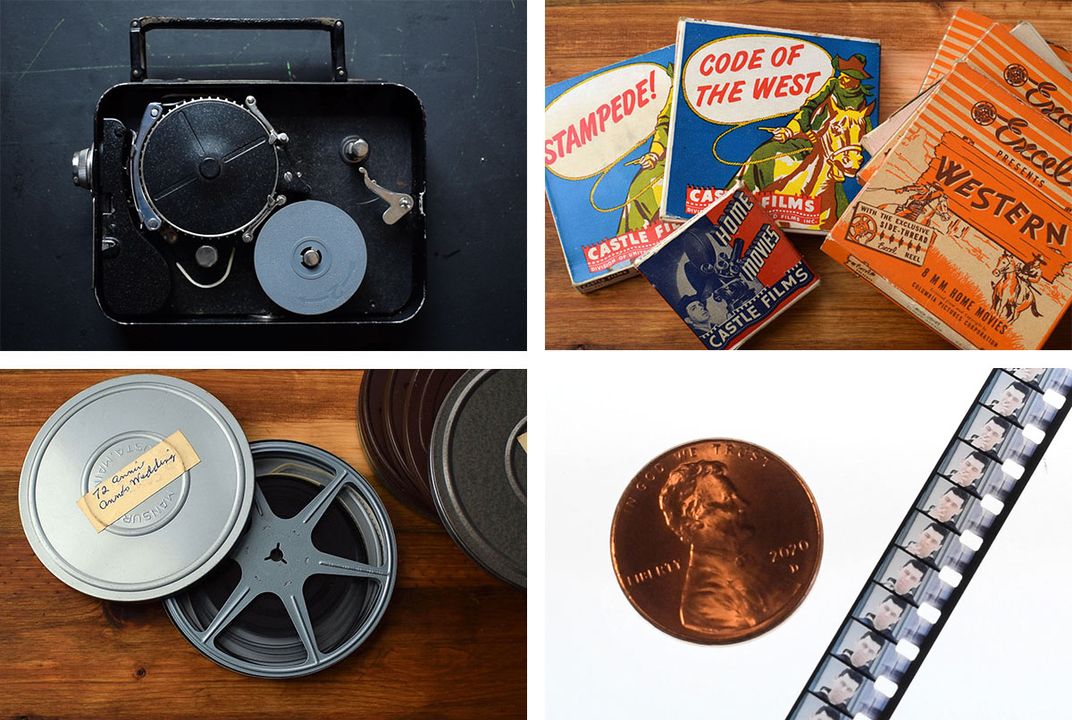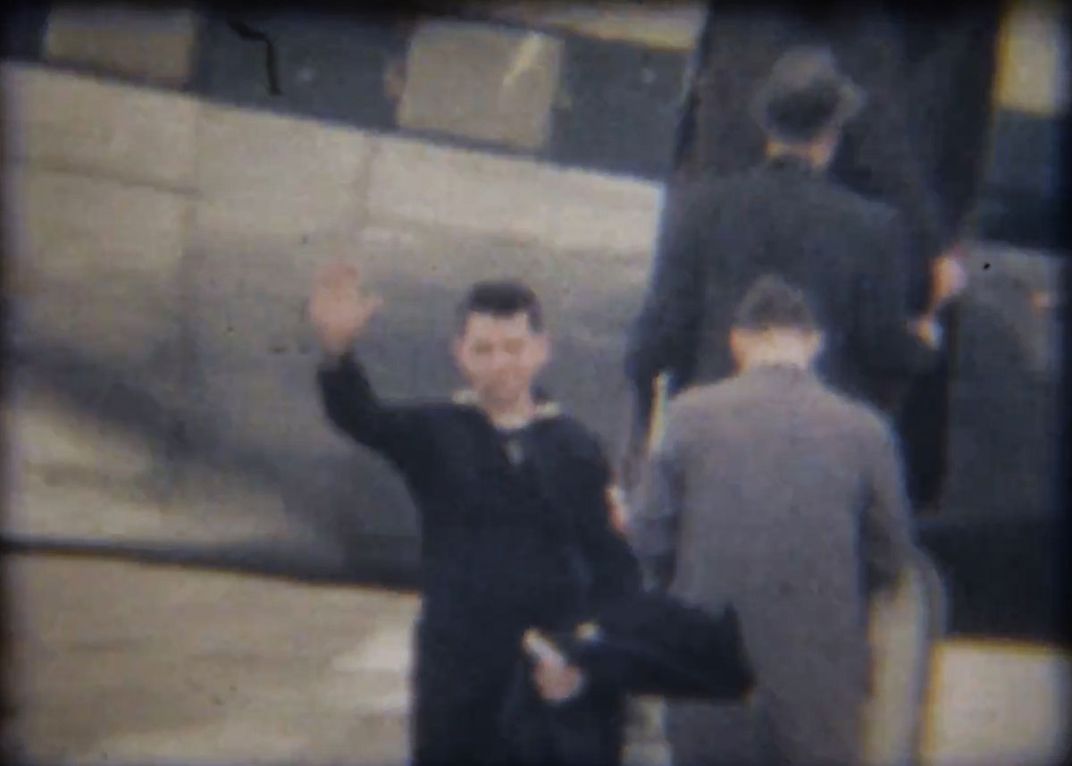SMITHSONIAN CENTER FOR FOLKLIFE & CULTURAL HERITAGE
How a Filmmaker Discovered a Powerful Message in a Box of Old Home Movies
A $12 purchase in a Liberty, Maine, antique store sparked a gumshoe investigation and a life rediscovered
:focal(600x434:601x435)/https://tf-cmsv2-smithsonianmag-media.s3.amazonaws.com/filer_public/97/f1/97f142bb-605c-46a9-840b-5432ccff79ad/roger-navy.jpg)
This is the first frame I saw of him
and the last one he’s in.
And I have no idea who he is.
In the summer of 2017, my friends and I came upon a very small town in Maine called Liberty. About a thirty-mile drive east of Augusta, you would be pressed to find it on a map. I was immediately drawn to the town’s antique store, what my mother would call a “junk shop.”
As I wandered the intriguing disarray of the second floor, I spotted a black metal box sitting on the stairs. Someone had taped a label on top:
“A Life $12”
The box was full of 8 mm films, and as I was a film student at the time, I wanted to go through them, but my friends were waiting outside, eager for the beach. Still, $12 seemed like a good deal.
At the shore, I unloaded the box onto a picnic table. The collection totaled thirty films: old westerns, sports reels, dated cartoons, and home movies.
I unraveled one of the loose reels a bit and held a segment up to the sun. At first, it was difficult to tell what I was looking at. Each frame was so small. I knew five could fit across the face of a penny. Squinting, I made out a man’s face. I unrolled a bit more. It looked like he was smoking. Was his the “life” the label referenced? I had to watch these reels.
One problem: I didn’t own an 8 mm projector. Kodak hadn’t made one since 1992, four years before I was born.
The box sat on my shelf for two years. I felt guilty every time I passed at it, but my life was so busy. One day, a friend expressed interest in the story and pressed me to pursue it. Newly determined, I bought an old projector, loaded up that first reel, and started watching.
There was that face I had seen two years before. He was smoking. He smiled. The silent film suddenly cut to him further away, standing alongside an older woman I assumed was his mother. He wore a blue sailor’s uniform and looked to be shipping off to war. He waved goodbye, then nothing. The film ended. I loaded up another reel.
Wait, is that him as a child? That kind of looks like him. Yeah, that’s definitely him.
It soon became a sort of scavenger hunt, finding him in each film. Some were easy; he popped up as soon as the light went on. Others were hard.
Is that kid’s hair black enough? Is that boy scrawny enough?
As I grew familiar with his face, I could pick him out of a crowd. I was watching him grow up, in a nonlinear, voyeuristic way. His was the $12 life.
In all the footage, he never looked older than he did when he got on that plane. It was clear. This was the last film he was in. And, based on the dates labeled on a few reels, it seemed he had shipped off to serve in the Korean War in the early 1950s. What had happened to him? I loaded up that first reel again and watched with this new context.
Now, his smile felt nervous. It faded as he took a drag from his cigarette. The smile was exchanged for a weary stare. The sailor and the woman posed together as if for a still photo, the woman clinging to the sailor’s arm, pulling him closer.
At the end of the reel, the sailor stood alone, his hands in the pockets of his peacoat—one last pose for the camera. He rocked back, took a step, and reluctantly drifted back toward the plane. Anxiously, he tapped his ticket against his jacket and walked up the stairs and into an uncertain future.
I watched the films through again, now not to play “I spy the sailor” but to discover who he was. I felt as if I had acquired a little time machine, one with dirty windows. I watched as the light projected the past on my wall. The films gleamed family gatherings and outings, vacations and birthdays, the building blocks of American community life. It appeared the sailor had many uncles, aunts, and cousins though he himself was an only child.
/https://tf-cmsv2-smithsonianmag-media.s3.amazonaws.com/filer_public/ce/b7/ceb790e3-2c84-4e28-acc0-a963e92ce9d4/roger-film-stills.jpg)
It was plain to see, through the many shots of him donning a rifle and a red mackinaw, that he was an avid hunter. There were many films of him hunting, from early in his youth to his adolescence, sometimes showing off his kill. In the summers, he loved taking the motorboat out for a spin. The camera operator made sure to get many shots of him speeding past the shore. In many of the shots, people lined up, shoulder to shoulder, as if staged for a photograph, as if they weren’t used to moving pictures. Eight-millimeter film for home movies became available in the 1930s, but the more popular Super 8 film was not released until 1965.
I was captivated by the people. They seemed so honest. What they wore, how they relaxed, what they did for fun, without the facades or phony transatlantic accents of those Cary Grant or Katharine Hepburn movies. The candid moments drew me. A young woman carelessly chewing gum next to a nun, her mouth gaping. I could spot the exact moment she understood the camera was rolling. She covers her mouth and bursts out laughing.
I grew fascinated by shared moments such as these, genuine rather than posed, documented with the purpose of sharing them again, human connections captured and preserved: a joyous wave from a neighbor on a snowy day, a quick smile to the camera operator, the visual balance formed by a little girl with a popsicle and an old man with a pipe sharing a conversation, or the clenched hand of a mother around her son’s arm before he deployed. I soon came to see them as rituals of connection and release.
In ritual, everyone plays their part. A consequence of photographic formats is that the face behind the camera is rarely seen. In all the films, not once does the person spin the camera around to reveal their face, nor come across a fortunately placed mirror. I could speculate all I want but could never know for sure who was behind the camera, though I guessed his parents. But their perspective is displayed; the films reveal what they value. The boy who grew up a sailor features in every film. Whether he’s having fun or acting reserved, he is usually the focus. It is clear whoever held the camera cared tremendously about this boy, logging the milestones in his life.

Films preserve the moments people hope to hang onto, but back then, film was expensive and sent away for developing. A normal three-inch reel contains fifty feet, about four minutes of watch time. Not everyone could afford it, and those who could made judgements every time their finger hovered over the shutter as to how those precious minutes should be used.
Formats have changed, but we still take photos and videos to document and remember our experiences. Today, we document our lives more than ever before. In my own digital archives, I’ve stored over half a million photos and videos. Will they end up in some future digital junk shop? Or will my memory be deleted?
I’m especially sentimental about the past and desire to document everything before it’s gone. Why is that? Where do people like me get the urge? Is it to stave off the impermanence of life? Some survival instinct? I fear that if something I experience is forgotten, it will be as if it never existed and become worthless. I feel the need to hold on.
This might be the last record of the man. I felt an obligation to discover his story, or at least his name. I looked for clues. The film had been sent out, developed, and returned. Someone handwrote names and an address on the boxes. I tried Google Maps. The house looked different from the one I saw in the films. I dragged around the view to see the house across the street. That was the house I saw him come out from. I had found his house. The name, written elegantly on one box read: C.F Gagnon. I searched the internet “C.F Gagnon Augusta, ME.” The results were unhelpful, obituaries either too young or too old for him and the Facebook page for a dentist.
Summer had come again. Leaving my home in Maryland, I headed up I-95 to Maine, the sailor’s address in my GPS. I turned down his street. Instantly, the scenery looked familiar. There was the house I had projected on my wall so many times before. It was strange seeing his house in front of me, something I had studied only in pictures, like the Hollywood sign or Angkor Wat. The unfamiliar familiar. The scale was finally cemented, the color corrected, the details clear.
“Private property” signs hung crookedly along the porch. I peeked into the broken windows. Construction buckets and drop cloths sat on the floor, although it looked like no one had been here for a while. I don’t think I had expected anyone to answer the door, invite me in, tell me all about the sailor, but I didn’t think the house would be falling apart. In my excitement, I had overlooked how long ago the Korean War ended. I stood there in the knowledge of what had been: the summers spent on the stoop watching traffic or the cats at play, the winters he wallowed in the snow while his mother watched from the window. The springtime walk back from church up that steep hill. A life held in film. Memories I now shared in.
As I walked back to my car, I saw a neighbor out on his porch with a cigarette. The memory of the sailor smoking came to mind. I went up and asked him if he knew anything about the people who lived there before. Inside, the man's wife, overheard me, and started yelling a suggestion of who my sailor might be.
“Is it Eugene?! Is it Eugene?! Mark, is it Eugene?!”
It wasn’t Eugene.
I drove off with the feeling that this was all I would get. A nameless $12 life in a box and an abandoned house.

I remembered the junk shop from two years before. I would ask the clerk where they got these kinds of things, find out where my box came from. She told me estate sales, donations, and auctions. There was no way to track my box. After two years, the end of the line. I decided to wander the store anyway, get lost in the act of looking. A wooden crate filled with photo slides poked out from under a dusty old end table. I knelt down, pulled one out, held it up to the light.
No way.
There was that face looking at me once again. It was the sailor.
I looked at the box of slides, and there, written clearly, perhaps in his own handwriting this time, was the name: Roger Gerald Gagnon. On my phone I typed his name into Google. An obituary. The photo above it showed an old man with small eyes, just like the sailor. White hair, not black, and he wore a Navy vet’s hat. He had survived the war after all.
The obituary described Roger, his love of hunting and boating, his joining the Navy—all things I learned from the films. He had served in the Korean and Vietnam wars. His parents’ names: Claudia B. and Carroll F. Gagnon.
He met his wife Tadako while stationed at the Naval Station in Great Lakes, Illinois. Later, he returned to Maine where he lived out the rest of his days. Tadako died in 2002. They never had kids. He was the end of the family line.
The obituary read, “A graveside service is scheduled for 1:00 PM on Friday July 7, 2017, in Augusta, ME”—only fifteen days before I found the $12 box.
There is a saying, though it has been said many ways, that a person dies twice: the first time when they physically die and the second when they are forgotten.
The films in the box will degrade, and everyone Roger had ever met will die. His memory would live on a bit longer through me and this story, but one day, Roger will be forgotten, as will I.
Some may say that nothing lasts and because of this, nothing matters. In meeting Roger, I have come to see things differently. Moments come and go, in families and communities. We choose what to make of them, what to remember, what to record. Every moment is special in the time it exists. So, yes, nothing lasts, but because of that, it all matters.
And at the root of everything, those human connections—the birthdays, the gum chewing, the boat rides, the goodbyes. They happen everywhere, all the time. In a life, $12.

Julian Martin-Poteet is a Brooklyn-based filmmaker and former intern at the Center for Folklife and Cultural Heritage. He is currently working on several projects including a documentary and experimental piece from his found films.
